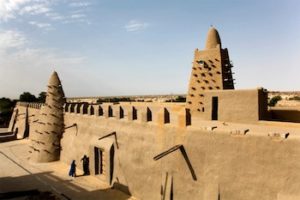
*Timbuktu is celebrated on this date in 1100. Timbuktu is a city in Mali, Africa, the capital of the Tombouctou Region, one of the eight administrative regions of Mali.
Timbuktu began as a seasonal settlement and became a permanent settlement early in the 12th century. After a shift in trading routes, particularly after the visit by Mansa Musa around 1325, Timbuktu flourished from the trade in salt, gold, ivory, and slaves. It became part of the Mali Empire early in the 14th century. Timbuktu was a medieval regional trade center where caravans met to exchange salt from the Sahara Desert for gold, ivory, and slaves from the Sahel, which could be reached via the nearby Niger River.
In the first half of the 15th century, the Tuareg people took control of the city briefly until the expanding Songhai Empire absorbed the city in 1468. A Moroccan army defeated the Songhai in 1591 and made Timbuktu, rather than Gao, their capital. The invaders established a new ruling class, the Arma, who, after 1612, became virtually independent of Morocco. The city's golden age as a significant learning and cultural center of the Mali Empire was over and entered a long period of decline. Different tribes governed until the French took over in 1893, a situation that resulted from the Berlin Conference and lasted until it became part of the Republic of Mali in 1960.
Between 1917 and 1921, during the colonial period, the French used slave labor to dig a narrow canal linking Timbuktu with Kabara. Over the following decades, this became silted and filled with sand. In 2007, the canal was re-excavated so that when the Niger River floods, Timbuktu is again connected to Kabara. The Malian government has promised to address problems with the canal's design as it lacks footbridges, and the steep, unstable banks make access to the water complex. Kabara can only function as a port from December to January when the river is fully flooded. When the water levels are lower, boats dock at Korioumé, which is linked to Timbuktu by a paved road.
Timbuktu is on the southern edge of the Sahara, 15 km (9+1⁄2 mi) north of the main channel of the Niger River. Dunes surround the town, and the streets are covered in sand. The port of Kabara is connected to an arm of the river by a 3 km (2 mi) canal. The canal had become heavily silted, but in 2007, it was dredged as part of a Libyan-financed project. In its Golden Age, the town's numerous Islamic scholars and extensive trading network supported a vital book trade, together with the campuses of the Sankore Madrasah. This Islamic university established Timbuktu as an academic center in Africa.
Several notable historical writers, such as Shabeni and Leo Africanus, wrote about the city. These stories fueled speculation in Europe, where the city's reputation shifted from extremely rich to mysterious. Timbuktu is impoverished and suffers from desertification. The population (2018 population 32,460) swelled from 10,000 in the 13th century to about 50,000 in the 16th century after establishing a major Islamic university (University of Timbuktu), which attracted scholars from worldwide.